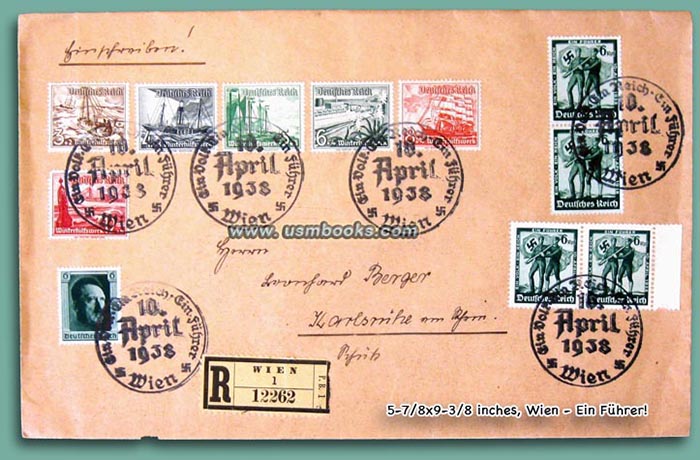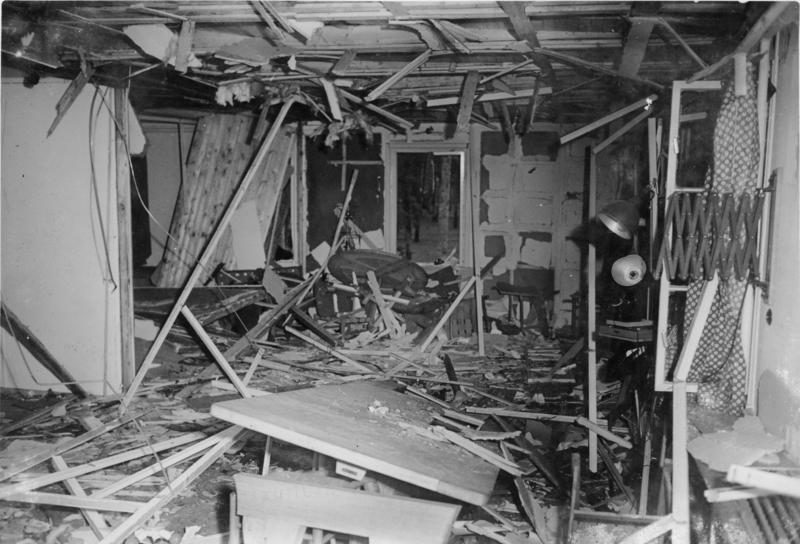RELG 330 - History of Christianity
Course Notes
![]()
Chapter 37
Images in the text are linked to larger photos - click on them to see the larger pictures.
Hover the mouse over the images to see their captions and copyright acknowledgments.
Page 527 - the Nazi Party, also known as the NSDAP - its full name was the Nationalsozialistische Deutsche Arbeiterpartei (National Socialist German Workers' Party).
Page 538 - Germany under Adolf Hitler.
Up until WWI (1914-1918) there were about 30 German States, with a variety of rulers (Princes, Grand Dukes, Archbishops, Prince Bishops, town councils) but with one Emperor or Kaiser who was "elected" by an electoral college of "Electing Princes", and who was usually from the Hapsburg family. It was a complicated mess, with traditions going back to the early Germanic tribes who elected their leaders.
After WWI government by an elected parliament was instituted, but in 1925 Adolf Hitler reorganized the Nazi party, and in 1932 the Nazi party was elected to the majority of seats in the parliament.
In 1933 Hitler was appointed as Chancellor of Germany, with Hermann Goering as Prussian Prime Minister and Goebels as Minister of Propaganda. Later that year Hitler was granted the powers of a dictator. Leading German scientists, writers, academics, teachers, and those of Jewish descent started to leave Germany.
Secret police and Nazi workers infiltrated society, and anyone who spoke out against the regime "disappeared" or was beaten up. The first concentration camps were set up, ostensibly to re-educate dissidents or undesirables - such as Jews, Gypsies, Poles, minorities, homosexuals, or anyone who spoke out - but really to work and starve them to death and eventually to shoot or gas them by the thousands.
Hitler continued to build up military forces, re-introduced compulsory military service, and appointed himself War Minister in 1938.
In 1939 Germany invaded Belgium, Poland, Bohemia, and Moravia.
Britain and France sent forces to aid the invaded countries, and World War II began.
Page 539 - the Holocaust is a term taken from the Hebrew Scriptures, and means a 'whole burnt offering'. There is a movement among Jews today to use the term 'Shoah' (wind, hurricane) rather than 'Holocaust', for the Nazi racial war against the Jews, on the grounds that a holocaust was performed as a free-will offering to God, whereas the extermination of the Jewish population was neither free-will nor acceptable to God.
See page 587 for a photo of the entrance to the Auschwitz-Birkenau concentration camp. Jews, Poles, Gypsies, and others were herded into railroad cars like cattle and brought to the concentration camp by rail.
 Page 539 - Hitler's religious position - although he was baptized and brought up in a Roman Catholic family, Hitler's attitude towards Christianity was cynical and unbelieving.
Page 539 - Hitler's religious position - although he was baptized and brought up in a Roman Catholic family, Hitler's attitude towards Christianity was cynical and unbelieving.
 He was prepared to 'use' Christian imagery for his own purposes - there is a photo of him leaving a Church building (presumably after attending a service) where he poses directly under the Cross in the Church door, making it look as if he is someone appointed by God. I am sure that this is a picture posed for propaganda. Other photos of Hitler at churches show him surrounded by admirers, and with smiling clergy in the background. The whole composition of this photo, with the position of the cross, and Hitler's seeming unawareness of the photographer smells of a carefully posed bit of propaganda.
He was prepared to 'use' Christian imagery for his own purposes - there is a photo of him leaving a Church building (presumably after attending a service) where he poses directly under the Cross in the Church door, making it look as if he is someone appointed by God. I am sure that this is a picture posed for propaganda. Other photos of Hitler at churches show him surrounded by admirers, and with smiling clergy in the background. The whole composition of this photo, with the position of the cross, and Hitler's seeming unawareness of the photographer smells of a carefully posed bit of propaganda.
 Until the time of Hitler, a favorite motto of Germany was "Ein Reich, ein Volk, ein Gott" (One realm, one people, one God). Hitler took that and changed it to "Ein Volk, ein Reich, ein Führer" (one people, one realm, one Leader) - and he took the title of Führer for himself, displacing God. The motto was used everywhere, even on postage stamps, and on the cancellations for postage, until it was ingrained into the unconscious minds of his subjects.
Until the time of Hitler, a favorite motto of Germany was "Ein Reich, ein Volk, ein Gott" (One realm, one people, one God). Hitler took that and changed it to "Ein Volk, ein Reich, ein Führer" (one people, one realm, one Leader) - and he took the title of Führer for himself, displacing God. The motto was used everywhere, even on postage stamps, and on the cancellations for postage, until it was ingrained into the unconscious minds of his subjects.
It is also recorded that Hitler would say "You see, it's been our misfortune to have the wrong religion. Why didn't we have the religion of the Japanese, who regard sacrifice for the Fatherland as the highest good? The Mohammedan religion too would have been much more compatible to us than Christianity. Why did it have to be Christianity with its meekness and flabbiness?".
Page 539 - Resistance to Nazism took many forms. Some Christian leaders spoke out against the system, and were persecuted and in some cases killed. There were also many less prominent people who resisted the system, sometimes by aiding Jewish neighbors to escape, or by hiding Jews from the Nazis.
"The Diary of Anne Franke" is the diary of a Jewish teenager who lived in hiding for a number of years until she and her family were betrayed and killed.
If found out, the families who sheltered Jews were often killed or sent to concentration camps. One such family was that of Corrie ten Boom in Holland. They were Dutch Reformed Christians who hid Jews in the cellar of their house, but were betrayed to the Nazis. Corrie's father was taken to a hospital by the Germans and left to die without treatment in a corridor. Corrie and her sister were sent to a concentration camp, where her sister died. Corrie ten Boom survived, and lived to work for reconciliation between the nations in post-war Europe. She wrote a book called 'The Hiding Place' recounting her experiences.
Page 540 - Karl Barth (1886-1968) (see page 568) was a Swiss Reformed pastor and theologian. His last name is pronounced 'Bart'. He rejected the nineteenth-century liberal views of Christianity, and also the extreme fundamentalism, and developed new methods. Barth pioneered dialectical theology, which stresses the dialectical nature of the divine - e.g. God's relationship to humanity is characterized by both grace and judgment. Barth emphasized the sovereignty of God, and took the Scriptures very seriously. He wrote a commentary on the Epistle to the Romans, and a 13-volume work on Church Dogmatics. However, he said that the angels in heaven were probably laughing at him for taking things so seriously.
During the 1930s Barth taught as a professor at several of the German Universities, and was one of the leaders of resistance to Hitler's Nazi regime. Barth became a leader of the Confessing Church in Germany, and in 1934 he formulated the Barmen Declaration, which repudiated Hitler's influence on the church. The Barmen Declaration stated that the Church owed allegiance to God, and said that the Church should resist coming under the influence of other lords such as the German Führer (Hitler). Barth mailed a copy of the Barmen Declaration directly to Hitler personally.
In 1935 Barth was thrown out of his position as Professor at the University of Bonn for refusing to swear an oath of allegiance to Hitler, and had to leave Germany. He returned to Switzerland (which was a neutral country throughout WWII, and which the Germans did not bother to invade), and became a professor at Basle University, where he lived until his death in 1968.
At the end of WWII Barth was a leader in a movement to express German guilt, responsibility, and penitence for the Third Reich (Hitler's regime) and WWII.
In 1962, on one of his lecture tours of the USA he was asked by a student if he could give a summary of his theology. Barth's reply was "Jesus loves me, this I know - for the Bible tells me so."
Page 543 - Dietrich Bonhoeffer - see page 575
Page 544 - the 1937 encyclical of Pius XI was entitled 'mit brennenden Sorge', which could more accurately be translated as 'with burning anxiety', though its English version (as given by the Vatican) does start with 'With deep anxiety . . '
Encyclicals are usually written in Latin, but this one was written in German because Pope Pius XI wanted it to be understood immediately by the German people.
 page 549 - The Assassination attempt on Hitler was an attempt to plant a bomb in his control room in the 'Wolf's Lair at Rastenburg.
The bomb was hidden in a briefcase, which was placed under the table where Hitler usually stood. Minutes before it detonated, someone saw the briefcase and moved it slightly to one side, so when the bomb detonated it did not kill Hitler.
page 549 - The Assassination attempt on Hitler was an attempt to plant a bomb in his control room in the 'Wolf's Lair at Rastenburg.
The bomb was hidden in a briefcase, which was placed under the table where Hitler usually stood. Minutes before it detonated, someone saw the briefcase and moved it slightly to one side, so when the bomb detonated it did not kill Hitler.
Dietrich Bonhöffer was thought to have been implicated, or at least to have had knowledge of the plot, so he was hanged by the Nazis shortly before Berlin fell to the allies.
Page 551 - Post-War Europe. At the conclusion of WW II Germany was divided into two parts -
"West Germany", (BRD - BundesRepublic Deutschlands, or FRG - Federal Republic of Germany) guided by an alliance of American, British and French forces;
and "East Germany" (DDR - Deutsche Democratische Republic) under the domination of Soviet Russian forces.
As the capital city, Berlin was also divided into two parts. The communists built the "Berlin Wall" to enforce separation between the two sectors.
People from East Berlin were shot and killed by the communists if they attempted to cross into West Berlin.
Visitors from West Berlin to East Berlin had to go through a processing station, called "Checkpoint Charley", where they gave up their passports and were assigned to the company of a "guide" who stayed with them to make sure they did not speak to any East Berliners. I myself went through that process because it was the only way to get to the Pergamon Museum, which housed many treasures from Mesopotamia, including the rebuilt Ishtar Gate of Babylon. It was a chilling experience.
I never expected that the Berlin Wall would come down within my lifetime.
Page 553 - Billy Graham. The text-book does not make it clear that there were many evangelists and evangelistic campaigns following the ministry of D.L.Moody, and that the ministry of Billy Graham was the culmination of this evangelistic period.
Go here for notes on evangelists, revivalists, and healers in the nineteenth- and twentieth-century church
Copyright © 2005 Shirley J. Rollinson, all Rights Reserved